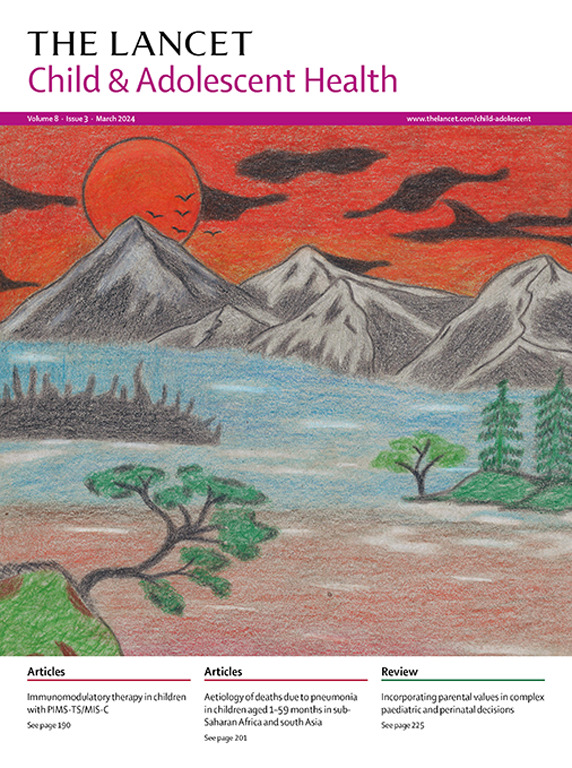在极早产儿和极早产儿(FONDUE)初始复苏中使用面罩和鼻罩装置:一项开放标签、单中心、随机对照试验
IF 15.5
1区 医学
Q1 PEDIATRICS
引用次数: 0
摘要
超过85%的极早产儿(孕32周出生)在出生后1分钟内自主呼吸,然而,超过60%的婴儿接受正压通气。出生后不久使用口罩可能会通过三叉神经反射抑制呼吸,导致声带闭合和缺氧。我们的目的是研究与面罩CPAP (fCPAP)相比,鼻罩持续气道正压通气(nCPAP)是否能提高CPAP的成功率,减少出生时正压通气和插管的需要。方法该开放标签、随机对照试验在莫纳什医学中心(墨尔本,VIC,澳大利亚)进行。符合条件的婴儿均为极早产儿(妊娠23周0天[23w0d] -31w6d出生),无已知的相关先天性异常。婴儿在出生前立即随机分配(1:1)接受nCPAP或fCPAP的初始呼吸支持。随机化采用预先生成的随机化计划,按胎龄分层(孕龄23w0 - 27w6d周vs孕龄28w0 - 31w6d)。由于干预的性质,研究人员或临床医生知道治疗分配,但试验统计学家对分配不知情。主要结局是CPAP的成功,定义为仅使用CPAP进行充分的呼吸支持,在新生儿入院前没有升级到正压通气或插管。主要结果在意向治疗人群中进行评估,其中包括根据分配治疗随机分配的所有婴儿。对所有随机分配的婴儿进行安全性评估。本研究已在澳大利亚新西兰临床试验注册中心前瞻性注册,编号为ACTRN12620001086954。在2020年12月2日至2023年3月17日期间,我们招募了151名婴儿:74名被分配到nCPAP, 77名被分配到fCPAP。平均妊娠28周6天(SD 2周6天),平均出生体重1155 g(381), 151例新生儿中82例(54%)为女婴。151名婴儿中有51名(34%)在妊娠28周之前出生。与fCPAP组相比,nCPAP组中更多的婴儿在没有升级到正压通气的情况下成功管理(74名婴儿中有43名[58%]vs 77名婴儿中有30名[39%];风险比为1.49 [95% CI 1.06 - 2.10])。每组两名婴儿死亡。fCPAP组77例婴儿中有3例(4%)发生气胸(nCPAP组无一例)。fCPAP组77例婴儿中有26例(34%)发生脑室内出血,nCPAP组74例婴儿中有19例(26%)发生脑室内出血。3名婴儿患有脑室周围白质软化(1名在fCPAP组,2名在nCPAP组)。每组两名婴儿因坏死性小肠结肠炎接受手术治疗,fCPAP组77名婴儿中有1名(1%)因肠穿孔接受手术治疗(nCPAP组无一例)。fCPAP组77名婴儿中有13名(17%)接受败血症治疗,nCPAP组74名婴儿中有14名(19%)接受败血症治疗。fCPAP组77名婴儿中有2名(3%)和nCPAP组74名婴儿中有7名(9%)接受了早产儿视网膜病变治疗。在极早产儿中,与fCPAP相比,出生时首次使用nCPAP更有可能导致CPAP成功,避免了正压通气的需要,减少了更高水平呼吸支持的暴露。澳大利亚国家健康和医学研究委员会和杰克·布罗克霍夫基金会。本文章由计算机程序翻译,如有差异,请以英文原文为准。
Face mask versus nasal mask device use for initial resuscitation in extremely and very preterm infants (FONDUE): an open-label, single-centre, randomised, controlled trial
Background
More than 85% of very preterm infants (born <32 weeks’ gestation) breathe spontaneously within 1 min of birth, however, more than 60% of infants receive positive pressure ventilation. Face mask application soon after birth might suppress breathing through the trigeminal nerve reflex, causing vocal cord closure and hypoxia. We aimed to investigate whether nasal mask continuous positive airway pressure (nCPAP) would improve CPAP success, reducing the need for positive pressure ventilation and intubation at birth, compared with face mask CPAP (fCPAP).
Methods
This open-label, randomised controlled trial was done at Monash Medical Centre (Melbourne, VIC, Australia). Eligible infants were very preterm (born at 23 weeks 0 days [23w0d]–31w6d of gestation) without known relevant congenital anomalies. Infants were randomly assigned (1:1) immediately before birth to receive initial respiratory support with nCPAP or fCPAP. Randomisation was done using a pre-generated randomisation schedule stratified by gestational age (23w0d–27w6d weeks vs 28w0d–31w6d gestation). Due to the nature of the intervention, investigators or clinicians were aware of treatment allocation, but the trial statistician was masked to allocations. The primary outcome was CPAP success, defined as adequate respiratory support with CPAP only, without escalation to positive pressure ventilation or intubation before neonatal unit admission. The primary outcome was assessed in the intention-to-treat population, which included all infants who were randomly assigned as per their allocated treatment. Safety was assessed in all randomly assigned infants. This study was prospectively registered with the Australian New Zealand Clinical Trials Registry, ACTRN12620001086954.
Findings
Between Dec 2, 2020, and March 17, 2023, we enrolled 151 infants: 74 were assigned to nCPAP and 77 to fCPAP. Mean gestation was 28 weeks and 6 days (SD 2 weeks and 6 days), mean birthweight was 1155 g (381), and 82 (54%) of 151 infants were female. 51 (34%) of 151 infants were born before 28 weeks’ gestation. More infants in the nCPAP group were successfully managed without escalation to positive pressure ventilation than infants in the fCPAP group (43 [58%] of 74 infants vs 30 [39%] of 77 infants; risk ratio 1·49 [95% CI 1·06–2·10]). Two infants in each group died. Pneumothorax occurred in three (4%) of 77 infants in the fCPAP group (none in the nCPAP group). Intraventricular haemorrhage occurred in 26 (34%) of 77 infants in the fCPAP group and 19 (26%) of 74 infants in the nCPAP group. Three infants had periventricular leukomalacia (one in the fCPAP group and two in the nCPAP group). Two infants in each group underwent surgery for necrotising enterocolitis and one (1%) of 77 infants in the fCPAP group had surgery for intestinal perforation (none in the nCPAP group). 13 (17%) of 77 infants in the fCPAP group and 14 (19%) of 74 infants in the nCPAP group were treated for sepsis. Two (3%) of 77 infants in the fCPAP group and seven (9%) of 74 infants in the nCPAP group were treated for retinopathy of prematurity.
Interpretation
In very preterm infants, compared with fCPAP, the initial use of nCPAP at birth was more likely to result in CPAP success, avoiding the need for positive pressure ventilation and reducing exposure to higher level respiratory support.
Funding
Australian National Health and Medical Research Council and the Jack Brockhoff Foundation.
求助全文
通过发布文献求助,成功后即可免费获取论文全文。
去求助
来源期刊

Lancet Child & Adolescent Health
Psychology-Developmental and Educational Psychology
CiteScore
40.90
自引率
0.80%
发文量
381
期刊介绍:
The Lancet Child & Adolescent Health, an independent journal with a global perspective and strong clinical focus, presents influential original research, authoritative reviews, and insightful opinion pieces to promote the health of children from fetal development through young adulthood.
This journal invite submissions that will directly impact clinical practice or child health across the disciplines of general paediatrics, adolescent medicine, or child development, and across all paediatric subspecialties including (but not limited to) allergy and immunology, cardiology, critical care, endocrinology, fetal and neonatal medicine, gastroenterology, haematology, hepatology and nutrition, infectious diseases, neurology, oncology, psychiatry, respiratory medicine, and surgery.
Content includes articles, reviews, viewpoints, clinical pictures, comments, and correspondence, along with series and commissions aimed at driving positive change in clinical practice and health policy in child and adolescent health.
 求助内容:
求助内容: 应助结果提醒方式:
应助结果提醒方式:


